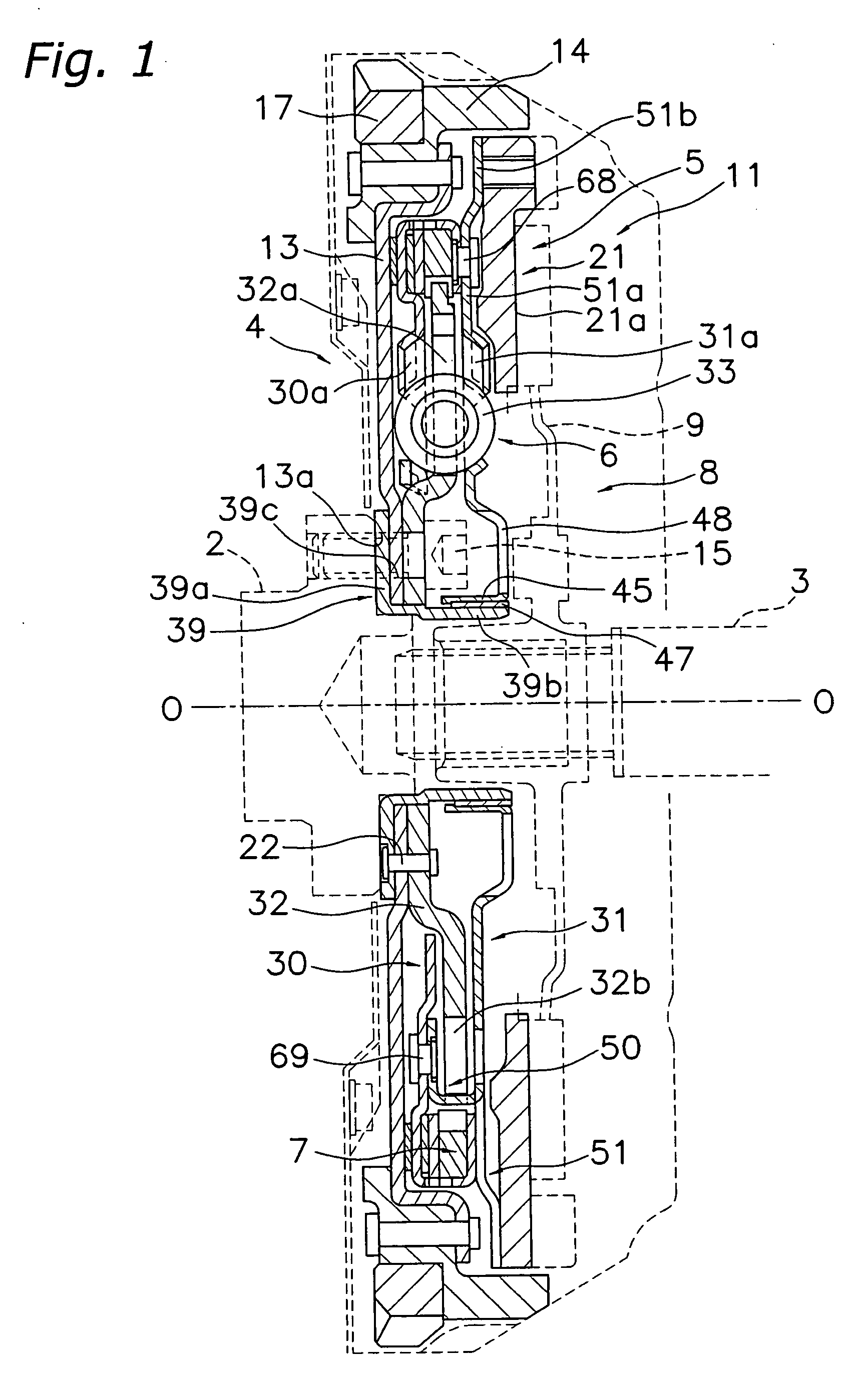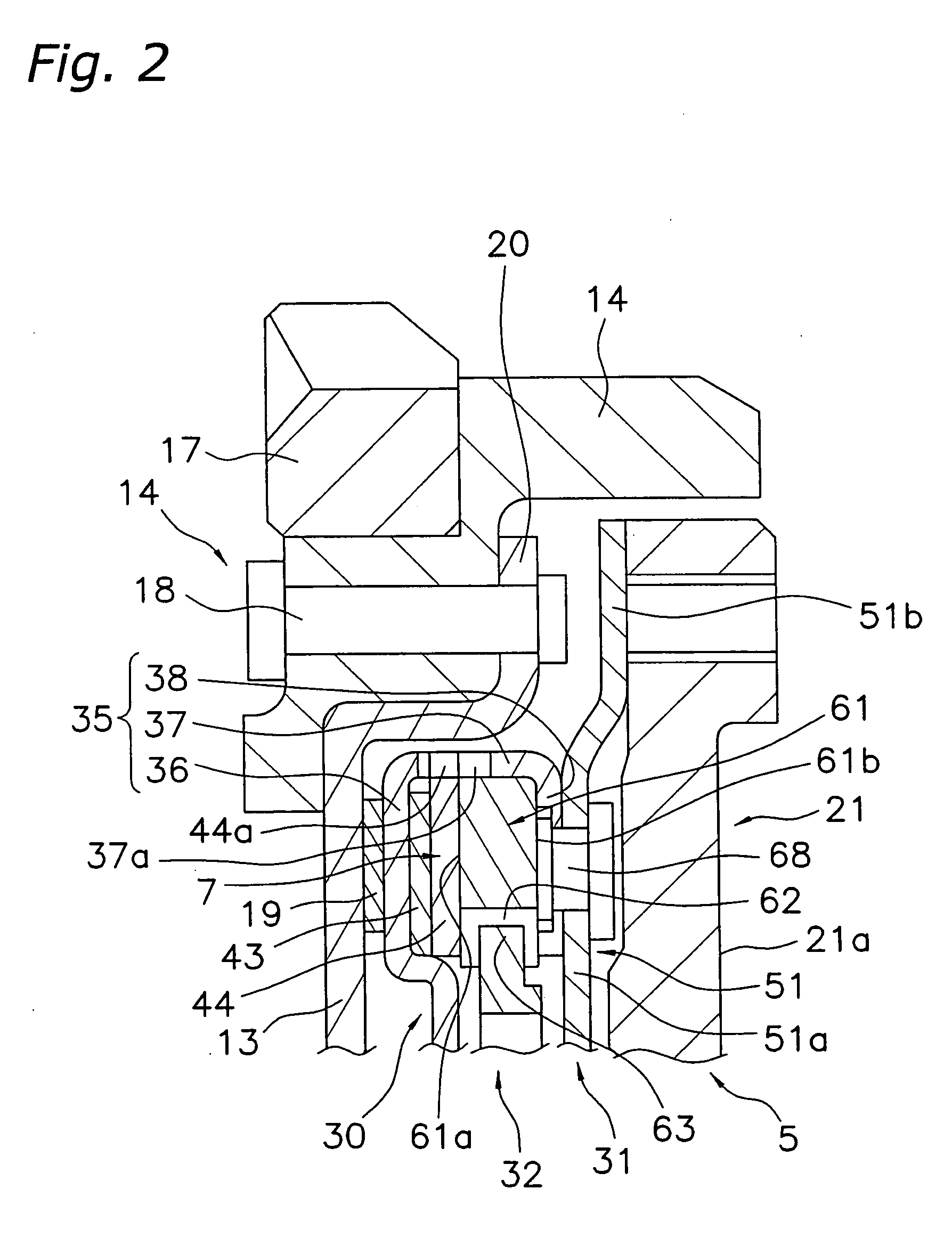Frictional resistance generation mechanism
a generation mechanism and friction resistance technology, applied in the direction of yielding coupling, vibration suppression adjustment, flywheel, etc., can solve the problems of low engine torque, abnormal transmission of vehicles, and considerable torque fluctuation
- Summary
- Abstract
- Description
- Claims
- Application Information
AI Technical Summary
Benefits of technology
Problems solved by technology
Method used
Image
Examples
second embodiment
[0137] (4) Second Embodiment
[0138] Another embodiment of the frictional resistance generation mechanism is described below with reference to FIGS. 14 to 17. The frictional resistance generation mechanism 107 is a mechanism that functions in parallel with a coil spring (not depicted) between a disk-like member 113 and output side disk-like plates 130 and 131 in the direction of rotation. When a flywheel 121 with a friction surface rotates relative to the crankshaft, a prescribed frictional resistance (hysteresis torque) is generated.
[0139] An annular first inertia member and second inertia member 114A and 114B are fixed to the radially outer portion of the disk-like member 113. The first inertia member 114A is disposed on the axial direction engine side, and the second inertia member 114B is disposed on the axial direction transmission side relative to each other. A disk-like plate member 115 is fixed between the first inertia member 11 4A and the second inertia member 114B. The radi...
third embodiment
[0159] (5) Third Embodiment
[0160] Another embodiment of the frictional resistance generation mechanism is described below with reference to FIGS. 18 to 21. Description of identical portions of the above-described embodiments is omitted.
[0161] 5-1) Frictional Resistance Generation Mechanism 207
[0162] As seen in FIG. 18, a frictional resistance generation mechanism 207 functions in parallel with coil springs between output side disk-like plates 232 and 233 and an input side disk-like plate 212 of a damper mechanism in the direction of rotation. Further, when a second flywheel 203 rotates relative to the crankshaft, a prescribed frictional resistance (hysteresis torque) is generated. The frictional resistance generation mechanism 207 generates a constant friction over an entire range of operating angles of the damper mechanism, and is designed to generate comparatively large frictional resistance.
[0163] The frictional resistance generation mechanism 207 is disposed in the space formed ...
fourth embodiment
[0186] (6) Fourth Embodiment
[0187] A friction resistance generation mechanism 307 related to a fourth embodiment of the present invention is described below with reference to FIGS. 22 to 27. In this embodiment, the basic structure of the friction resistance generation mechanism 307 is the same as the friction resistance generation mechanism 207 in the above-described embodiment. A description of identical portions is omitted below, and emphasis is placed on portions that differ.
[0188] The widths in the direction of rotation (the angles in the direction of rotation) of friction engagement members 363 are all the same, but some of the widths in the direction of rotation (the angles in the direction of rotation) of the concavities 362 may be different. That is to say, there are at least three types of friction shims 361 with differing widths in the direction of rotation of the concavities 362. In this embodiment, these are composed of two first friction shims 361A that face each other ...
PUM
 Login to View More
Login to View More Abstract
Description
Claims
Application Information
 Login to View More
Login to View More - R&D
- Intellectual Property
- Life Sciences
- Materials
- Tech Scout
- Unparalleled Data Quality
- Higher Quality Content
- 60% Fewer Hallucinations
Browse by: Latest US Patents, China's latest patents, Technical Efficacy Thesaurus, Application Domain, Technology Topic, Popular Technical Reports.
© 2025 PatSnap. All rights reserved.Legal|Privacy policy|Modern Slavery Act Transparency Statement|Sitemap|About US| Contact US: help@patsnap.com



